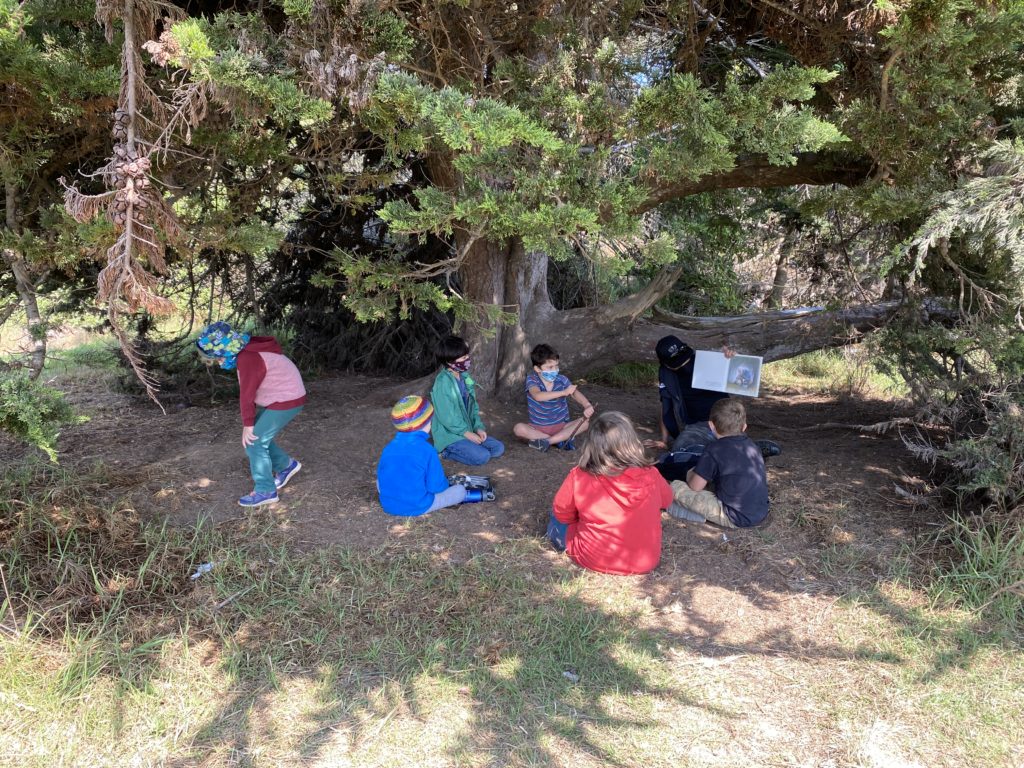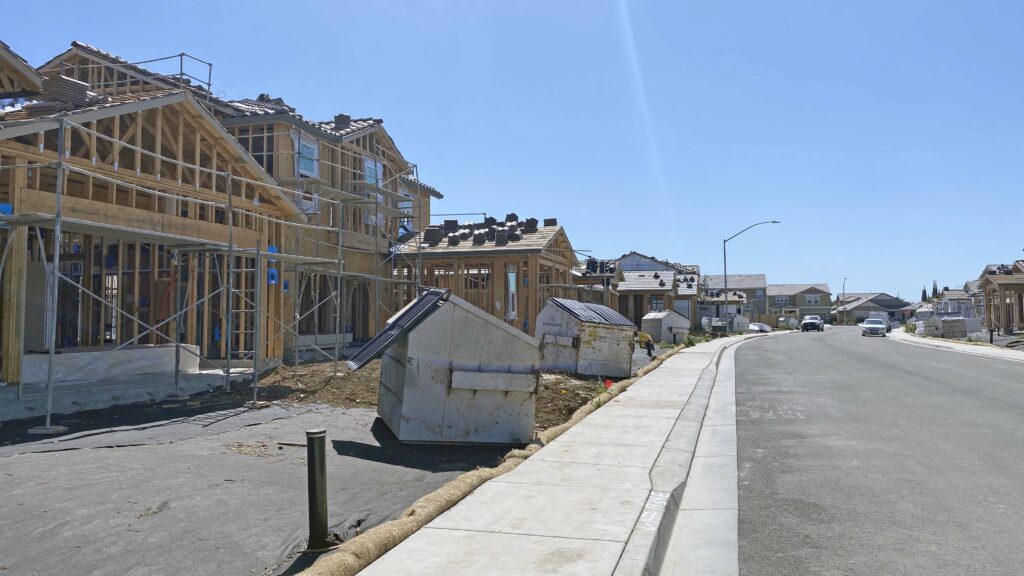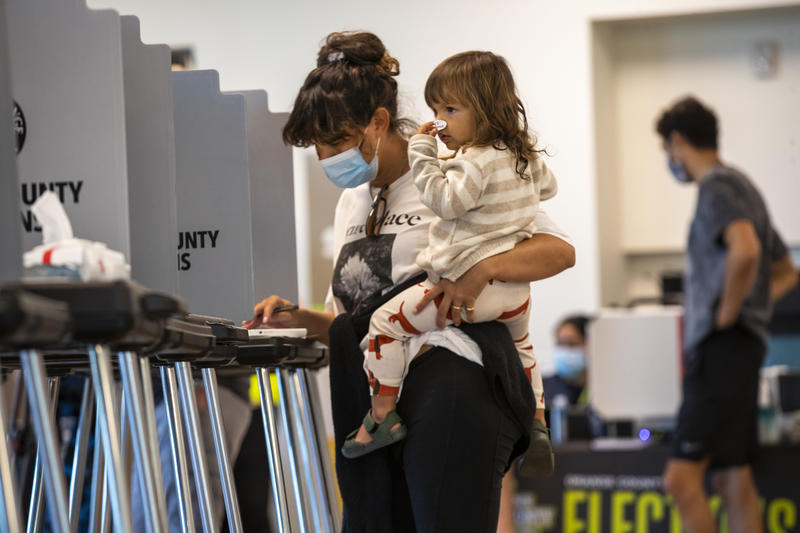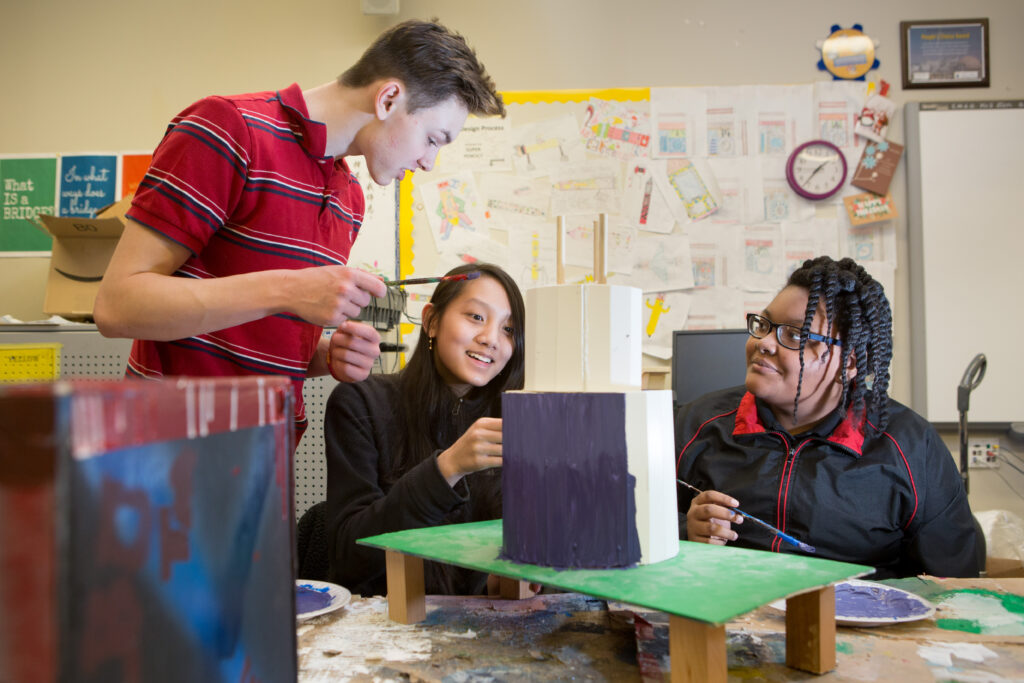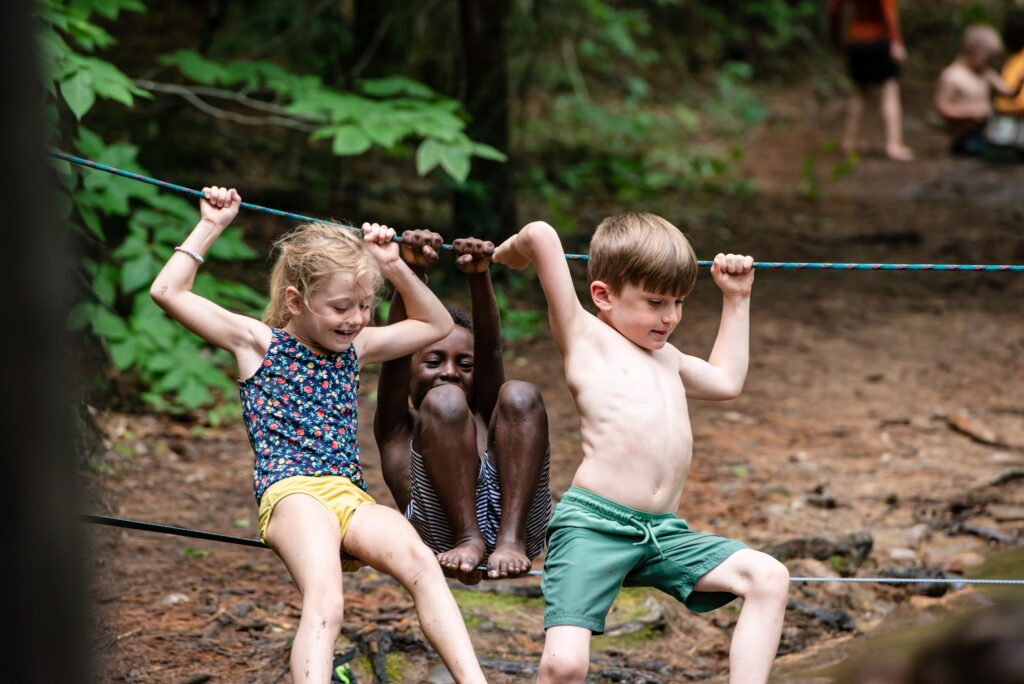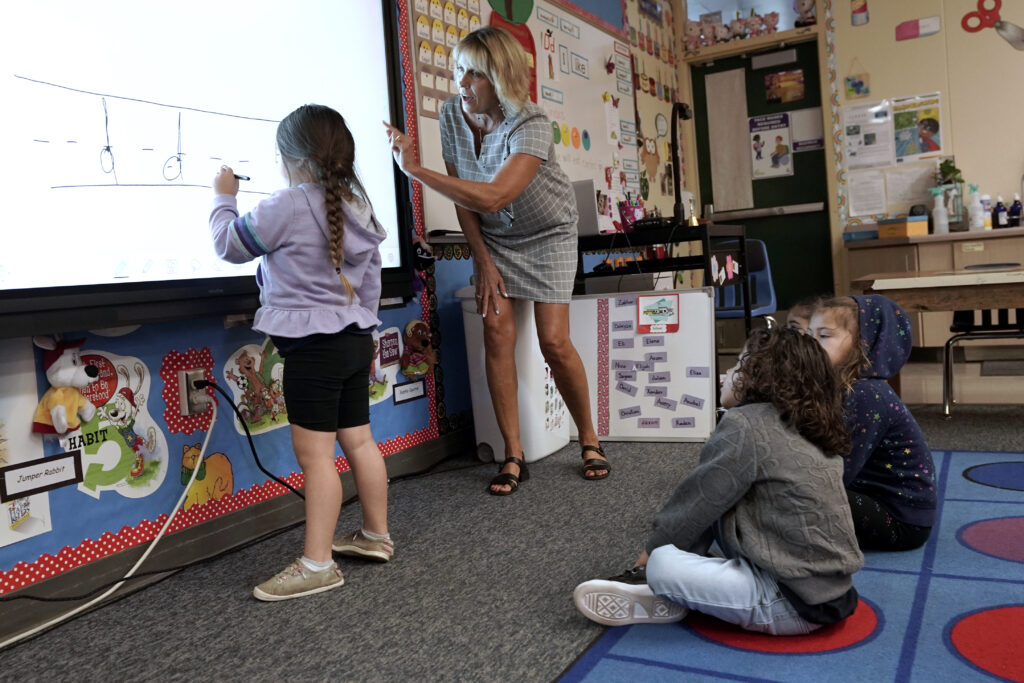
Trees are teaching tools at the Berkeley Forest School. Credit: Courtesy of the Berkeley Forest School
At a forest school, the roof is the bright blue sky, a cluster of ladybugs flying through the air can turn into a science lesson and the fog lingering on your face becomes an example of the water cycle.
Learning amid the leaves is the core of the curriculum in outdoor early learning programs, which often focus on children aged 3 to 5. Mother Nature provides the classroom where the littlest learners can dig up snake skins, bury treasure maps and climb trees, steeping in the myriad wonders of life.
Yet, that’s the exception to the rule these days, as many preschool children spend too much time indoors huddled around screens. Despite the fact that time in nature increases opportunities for play and exercise, boosting children’s health and development and reducing hyperactivity — the bane of our short-attention span era — most American preschoolers don’t get enough time outdoors, according to a new national report from the National Institute for Early Education Research (NIEER).
“Outdoor nature-based learning is vital for young children’s health, development, and education,” according to the report, which was written by W. Steven Barnett, the institute’s senior co-director and founder, and Kate Hodges, an early childhood education policy specialist. “Increased screen time and reduced exposure to nature are linked to serious health problems, such as obesity, diabetes, hyperactivity, stress, asthma, and allergies.”

Sharpening a sense of stillness, calm and focus is easier for children in a natural setting, experts say. Amid the post-pandemic rise in child behavioral issues, some suggest that outdoor education might be an antidote to shattered attention spans and frayed nerves.
“The kids are play-deprived,” said Angela Hanscom, a pediatric occupational therapist and founder of Timbernook, a research-backed therapeutic play program. “Once they dive deep into the play, they calm down. It’s very interesting to watch. Being outside also helps you get you into an alert state of mind, which is ideal for the brain.”
Giving children enough time for free play, experts say, may make it easier for them to sit quietly at their desk later. As with many aspects of the educational system, the risks of getting stuck too long indoors are elevated for low-income students, according to the institute’s report.
“These issues are particularly concerning for low-income children who often have limited access to safe outdoor spaces. By prioritizing nature-based learning in early childhood programs, states can help mitigate these health risks.”
Hanscom notes that in an attempt to keep kids safe, we may have unwittingly put them in a new kind of danger. Some of the children she works with now require the kind of physical therapy, particularly balance and flow exercises, that were previously reserved for the geriatric. We force children to sit still at an age when they are built to move, she says, which has hampered their development.
“Their neurological system is not developing properly,” Hanscom said. “We’re overly restricting children’s ability to move and play in pretty profound ways, and we’re actually causing harm to their development now. They’re literally falling out of the chairs and they’re having trouble paying attention, and they’re becoming more and more clumsy in their environment.”
The lack of nature exposure in many kindergarten programs is ironic given that the term originated with visionary 19th century educator Friedrich Froebel, the founder of the kindergarten movement, “who believed that children are like flowers and need care and cultivation to grow and blossom, hence the name,” notes Barnett. Froebel’s original program featured an actual garden in which children each tended to their own plots.
“Learning through nature was an important part of the program,” said Barnett. “Froebel also emphasized the preparation of highly proficient teachers, so it was not just the outdoor/nature aspect that has been lost.”
Rethinking the preschool experience to include the myriad wonders of the natural world is part of the purpose of the report. There is much to be learned from stomping through puddles, scrambling over fallen logs and digging in the dirt with sticks, some say.

“Considering that many preschool children attend for at least four to six hours per day, leaders should consider whether 30-60 minutes of outdoor time is sufficient,” said Barnett. “Many lessons can also be learned from forest or outdoor preschools in which children interact with a natural landscape and spend the entire preschool day outside.”
Rooted in the Scandinavian education tradition, forest schools got a huge boost in popularity during the pandemic as a safe way to keep learning going even when buildings were closed. There are roughly 800 nature preschools in the U.S., a 200% increase since 2017, according to a survey by the Natural Start Alliance.
Science has long suggested that children’s mental and academic health can be buttressed by increasing exposure to nature while decreasing time online. One report, which distilled the results of 186 studies, noted that most researchers find that time spent in nature contributes to both psychological stability and academic agility. Time spent gazing at glowing screens, meanwhile, has often been associated with poor outcomes, including increased mental illness and diminished cognition. That should not come as a surprise, experts suggest.
“Natural spaces are the context the human body has evolved in,” said Lia Grippo, founder of Wild Roots Forest School in Santa Barbara. “Our bodies expect variations in light, air temperature and movement, sights and sounds far and near, uneven terrain, space for a plethora of movements, and a host of life around us, doing what life does. When these expectations are met, we tend to be alert and relaxed. This is the state we learn best in.”
More outdoor time has also been associated with better executive functioning. One study of 562 Norwegian preschoolers found a link between time spent outdoors and sharpened executive functioning, which includes attention and short-term memory. That study also found a connection between too much time indoors and hyperactivity symptoms.
“Outdoor and nature-based preschool activities contribute to children’s health development directly, support more complex play,” said Barnett, “and offer a teaching tool for children to learn about nature and the environment.”
When Grippo taught at a traditional preschool, she tried hard to get the children outside into green spaces for playtime. She noticed that a lot of behavioral issues disappeared when the little ones were playing in meadows or woodlands. The children were quickly soothed by the pleasures of the natural playground, she said.
“Over time, this pattern became painfully clear,” said Grippo, who learned to forage in the woods as a child in Latvia. “Many of the problems I was working with were in fact problems of the environment rather than the children. Over the next few years, I spent more and more time in natural settings with the children until I finally abandoned the indoor space all together. It was the children who showed me what they needed.”
Anything children encounter in nature can become a springboard to learning, some say. A dead bug can spark a discussion about the circle of life. A muddy stream becomes an art studio for a clay-based art project. A stack of sticks can be the raw material to build a fort in the forest.
“Young children need a tremendous amount of movement in order to develop the capacity for stillness,” said Grippo, president of the California Association of Forest Schools. “They need an environment that offers a rich diversity of experiences with a healthy blend of predictability and novelty, in order to incorporate new information and understanding. They need to feel a part of a large family, larger than just the human family. Nature provides for all of these needs.”

Boosting opportunities for exploration and free play is just one reason that the National Institute for Early Education Research report argues that little children need more outdoor time. Play, some experts suggest, may well be characterized as the superpower of the young. A growing body of research suggests that play may even be a way to help close the achievement gap.
“Just one of the many important reasons for increasing preschoolers’ time in natural spaces is that it improves the amount and quality of young children’s play,” said Barnett. “Research suggests that additional guidance and funding to support outdoor, nature-based learning in preschool settings could lead to positive early childhood educational experiences and cognitive, physical and social-emotional benefits for young learners.”
For the record, California fares better than many states because it requires some outdoor time in its subsidized preschool program, the report suggests, but it fares less well in terms of supporting nature-based schools in general.
“California is among the states with stronger policies because it requires outdoor time every day for a substantial portion of the day, sets standards for air quality for children’s outdoor time, and requires preschool programs to have outdoor space,” said Barnett. “However, it is not one of the leaders with policies specific to outdoor and nature-based programs, which do not always fit well into the usual regulations for preschool and child care programs.”
While California has more outdoor schools than most states, it should be noted that most forest schools aren’t licensed in the Golden State because they often do not have a permanent indoor venue. Washington became the first state to license outdoor preschools in 2019. There are roughly 80 such schools in California, according to the California Association of Forest Schools.
Given its storied roots and the exhaustive research proving its efficacy, why has outdoor education struggled to take root in the American educational system? Why do many assume that schooling should be dominated by fluorescent lighting, asphalt and edtech?

“Inadequate funding explains a lot,” said Barnett. “We don’t invest in preschool teachers and, as a result, many do not have the knowledge and skills needed. Legal worries probably make it seem risky. Public programs tend to be built as cheaply as possible with no consideration for beauty or nature. Even for older children, it is hard to tell the difference between schools and prisons when they are being built.”
While some teachers can’t wait for the latest ed-tech breakthrough to engage their students, others point to the majesty of the natural world and its ability to spark our curiosity.
“Nothing I can do as an educator can begin to approximate the depth and breadth of what the natural world has to offer,” said Grippo. “Nature teaches us to pay attention, expand awareness, move with aliveness and agility, respond to our environment, experience awe, gratitude and love, develop fortitude, make mistakes and try again, and all in a space that makes the body healthier, happier, and smarter.”
